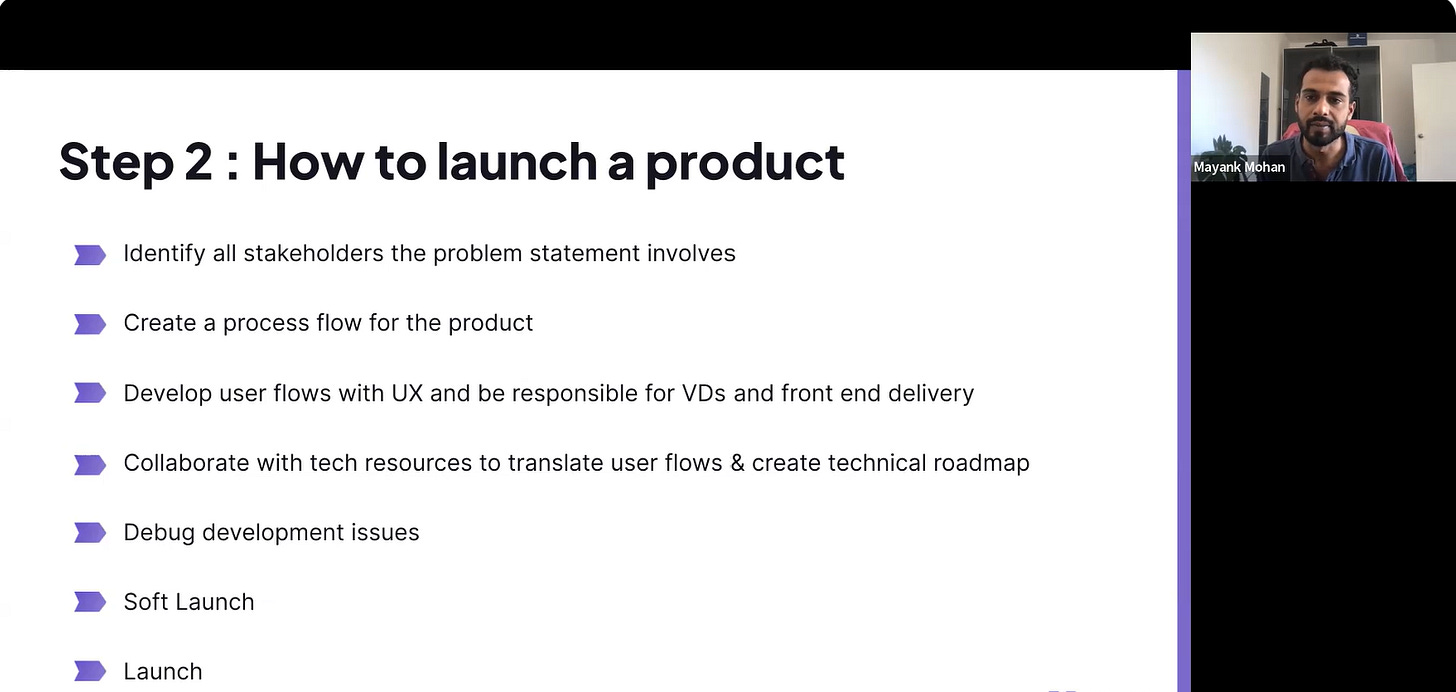🤷♂️ Takeoff #38: Escaping the Trap of Product-Led Growth
This is Takeoff, we're like the perfect cocktail that won't burn a hole in your pocket. Refreshing, affordable, and one of a kind - you won't find anything like us anywhere else.
🤔 What happened at Airtribe this past week?
👉 The third cohort of the Product Management Launchpad graduated this week! 🎓 This was the first cohort that followed a different model of multiple instructors. It was a wonderful journey with our instructors, mentors and learners. Apart from being a successful cohort, it was one where a solid impact was made!
👉 Our first cohort of the Backend Engineering Launchpad had their first week of lives sessions. They learnt the fundamentals of Node JS, introduction to algorithms and Big O Notation as well as a deep dive into async programming. It was a week full of learning! 😀
👉 We had a masterclass by Mayank Mohan, Co-founder of Ubuntwo and the Ex-Head of Product & Partnerships at Zilingo. It was on Product Strategy Unlocked: How to Create Winning Products Every Time. Throughout the session, learners were equipped with the right framework and approach to craft the ideal product strategy for products.
😎 What’s new at Airtribe?
After conducting multiple such sessions with our founders, we're back with another one! 🥳
This time, with product expert and mentor of our Product Management Launchpad, Malay Krishna. We also have Navneet Sharma joining him to answer any questions on Airtribe. 😀
Join them for a free session and determine whether product management is the right career for you!
When? 26th April, 7:30 PM IST. ⏰
🍾 Recent success stories at Airtribe
Rahul Gupta, a learner from our Product Management Launchpad, has recently been promoted to Senior Product Manager at Manipal Business Solutions.
Rahul Chopra, another learner from our ongoing cohort on Product Management Launchpad, has been promoted to Product Manager at ProjectHero!
Suraj Murali, one of our mentors, has also recently become a Product Manager at Paytm.
Congratulations to these individuals! We take great satisfaction in being able to make a positive impact on people's lives. 💜
If you're interested in learning more about our program, click the link below:
🪤 Trap of Product-led growth
Today, all companies strive for efficient growth. Nevertheless, how can you attain such growth in a seemingly saturated market? What should you do if your marketing endeavours fall short, your sales team generates few leads, and your product's greatness goes unnoticed?
The solution is straightforward: implement a product-led strategy and allow your product to lead your sales efforts.
The approach aims to create a product that is so good that it will generate word-of-mouth marketing and lead to increased adoption rates. The idea is that by creating a great product, customers will naturally want to share it with others, leading to increased growth and revenue for the business.
Consider the PLG giants, like Slack and Dropbox, which have succeeded immensely. These products don't require a sales pitch as users are drawn to their superiority and recommended by others. As a result, acquisition costs are either minimal or non-existent.
Moreover, with a product-led approach, users experience the product's value before making any payment, leading to a more positive user experience and efficient upselling. Scaling a business with a sales-led approach involves hiring more salespeople, leading to increased overhead costs. In contrast, a product-led growth model enables infinite scalability without adding to the overhead costs.
However, while PLG can be an effective growth strategy, it can also be a trap for businesses that rely on it too heavily.
One of the main traps of PLG is that it can lead to a product-focused culture that prioritises growth over all else. When businesses become too focused on product growth, they can lose sight of other important factors such as customer satisfaction, user experience, and long-term sustainability. This can lead to a cycle of constantly releasing new features and updates to keep up with competitors, without considering whether those features are actually meeting the needs of their customers or not.
Additionally, PLG can create a false sense of security for businesses. While a great product can certainly drive growth, it is not a guarantee of success. Businesses that rely too heavily on PLG can become complacent and fail to innovate, assuming that their product will continue to generate growth without any additional effort.
Finally, PLG can be a trap because it is not a one-size-fits-all solution. While PLG can be effective for certain types of businesses and products, it may not be the best approach for others. Businesses that blindly adopt PLG without considering their unique needs and circumstances may find themselves struggling to generate growth or facing other challenges.
In conclusion, while PLG can be an effective growth strategy for businesses, it is important to approach it, cautiously. Businesses that rely too heavily on PLG can fall into a number of traps, including a product-focused culture, a false sense of security, a lack of differentiation, and an approach that may not be suitable for their unique needs. To avoid these traps, businesses should approach PLG as one part of a broader growth strategy that takes into account all aspects of their business, including their customers, competitors, and long-term sustainability.
Do you agree? Let us know in the comments. 💬
❓Can you answer it?
What does nobody want, yet nobody wants to lose?
Tell us your answer in the comments below 👇
Thank you for your continued support and interest in our work. We are grateful to have you as a reader. 🙏
Wishing you all the best, and until next time, take care and stay curious! 🤗










